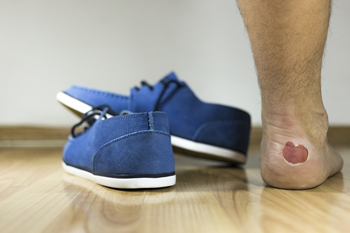 The definition of a blister is a small pocket that is filled with fluid. This can develop as a result of consistent friction that can come from wearing shoes and socks that do not fit correctly. It is the body’s natural healing response to skin that has become damaged. When new skin has formed under the blister, it will gradually drain, and is no longer needed. It may be helpful to protect the blister with a protective covering while daily activities are being completed. It is beneficial to remove the covering or bandage while sleeping as this may help to accelerate the healing process. Blisters may be prevented by wearing shoes and socks that fit correctly, and this can be accomplished when they are purchased in the afternoon, when the feet are at their largest. If you would like additional information on how to treat and prevent blisters from developing on the feet, please speak with a podiatrist.
The definition of a blister is a small pocket that is filled with fluid. This can develop as a result of consistent friction that can come from wearing shoes and socks that do not fit correctly. It is the body’s natural healing response to skin that has become damaged. When new skin has formed under the blister, it will gradually drain, and is no longer needed. It may be helpful to protect the blister with a protective covering while daily activities are being completed. It is beneficial to remove the covering or bandage while sleeping as this may help to accelerate the healing process. Blisters may be prevented by wearing shoes and socks that fit correctly, and this can be accomplished when they are purchased in the afternoon, when the feet are at their largest. If you would like additional information on how to treat and prevent blisters from developing on the feet, please speak with a podiatrist.
Blisters are prone to making everyday activities extremely uncomfortable. If your feet are hurting, contact Dr. Derek T. Pantiel of Summit Podiatry. Our doctor can provide the care you need to keep you pain-free and on your feet.
Foot Blisters
Foot blisters develop as a result of constantly wearing tight or ill-fitting footwear. This happens due to the constant rubbing from the shoe, which can often lead to pain.
What Are Foot Blisters?
A foot blister is a small fluid-filled pocket that forms on the upper-most layer of the skin. Blisters are filled with clear fluid and can lead to blood drainage or pus if the area becomes infected.
How Do Blisters Form?
Blisters on the feet are often the result of constant friction of skin and material, usually by shoe rubbing. Walking in sandals, boots, or shoes that don’t fit properly for long periods of time can result in a blister. Having consistent foot moisture and humidity can easily lead to blister formation.
Prevention & Treatment
It is important to properly care for the affected area in order to prevent infection and ease the pain. Do not lance the blister and use a Band-Aid to provide pain relief. Also, be sure to keep your feet dry and wear proper fitting shoes. If you see blood or pus in a blister, seek assistance from a podiatrist.
If you have any questions, please feel free to contact one of our offices located in Wilmington, Whiteville, and Burgaw, NC . We offer the newest diagnostic and treatment technologies for all your foot care needs.
Read more about Blisters on the Feet